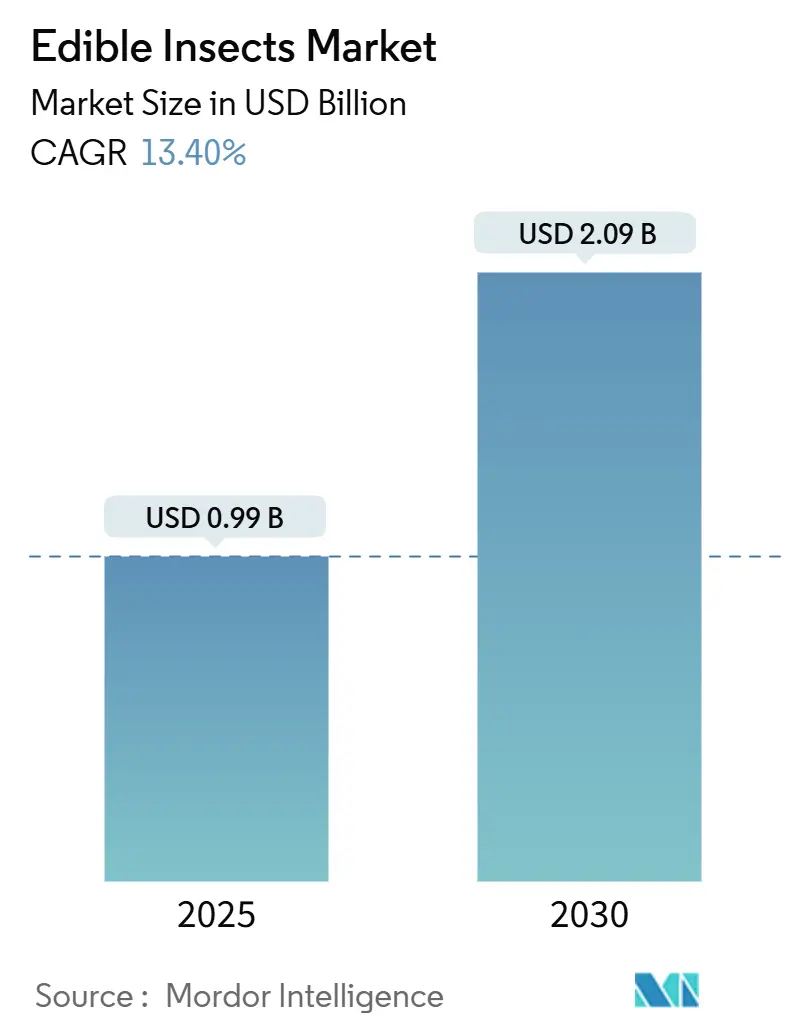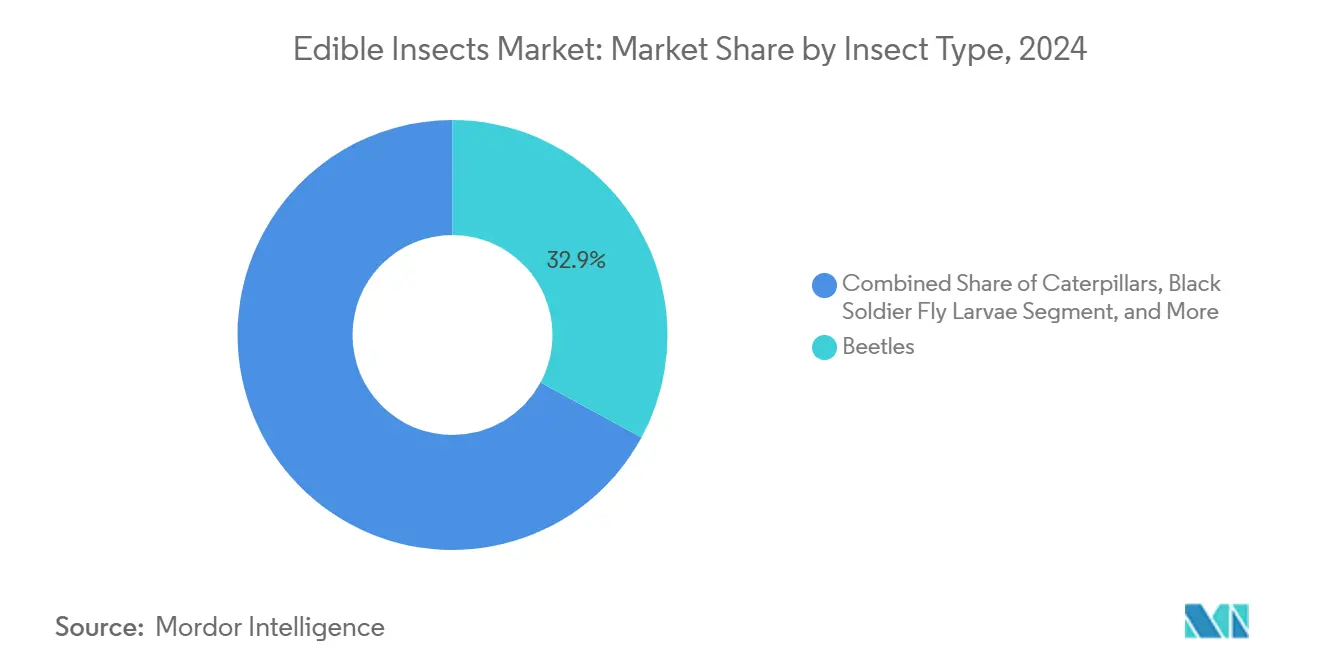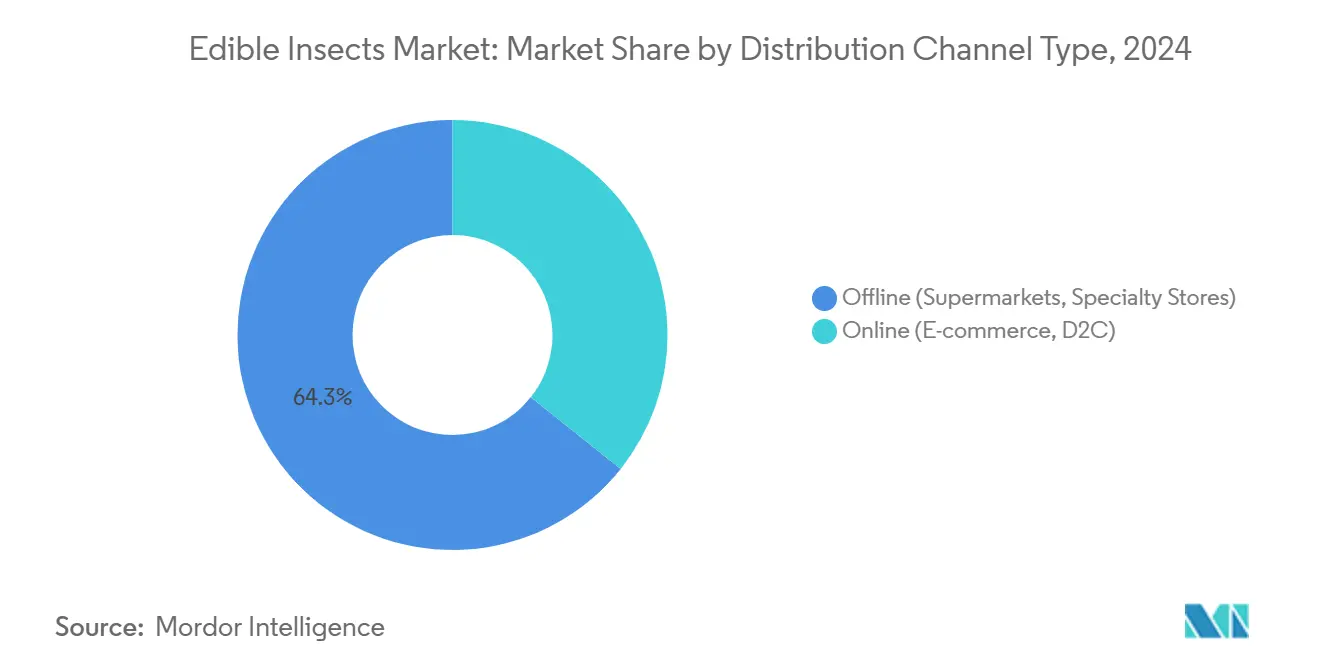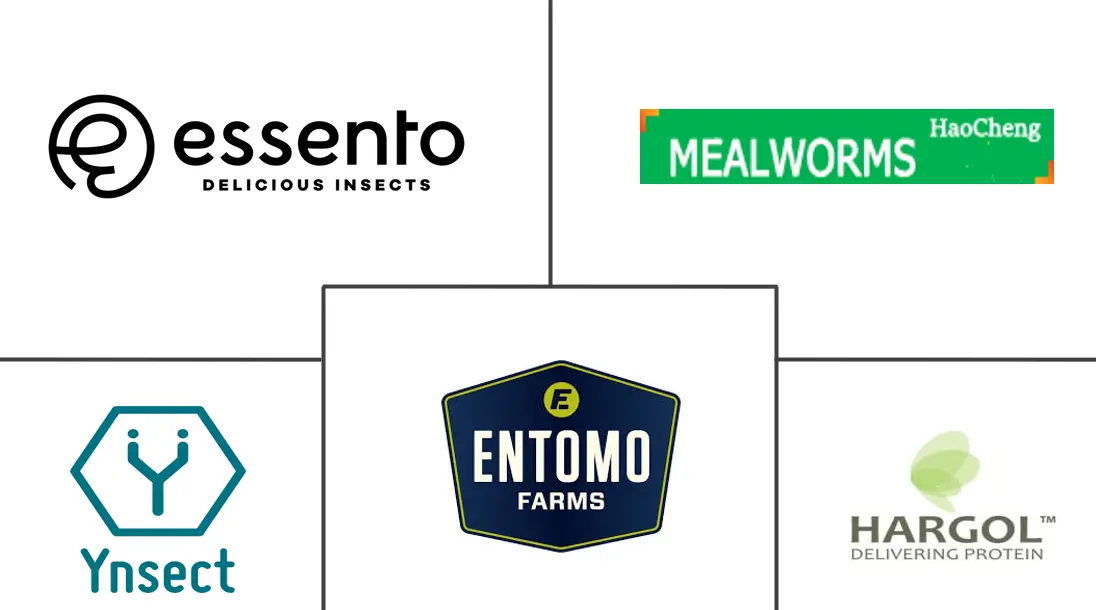Edible Insects Market Size and Share

Edible Insects Market Analysis by Mordor Intelligence
The edible insects market size is valued at USD 0.99 billion in 2025 and is forecast to reach USD 2.09 billion by 2030 at a 13.40% CAGR during the forecast period. Growth rests on converging factors, formal approvals of additional insect species in the European Union, rising consumer exposure through food-service channels, technology-driven efficiency gains in automated vertical farms, and expanding demand from premium pet-food brands that need novel proteins. Investors are also increasingly drawn to the sector because carbon-credit revenue can offset production costs, while blockchain traceability platforms reduce supply-chain risk. Regional performance shows notable differences. The Asia-Pacific region contributes nearly two-fifths of global volume, supported by its deep-rooted entomophagy practices. Meanwhile, North America is growing at a faster pace, driven by sustainability-focused consumers and changing regulatory perspectives. Segment trends align with these developments, beetles currently lead in volume, but crickets are growing the fastest as processors prioritize neutral-flavored, high-protein options.
Key Report Takeaways
- By insect type, beetles led with 32.9% share of the edible insects market in 2024, and crickets are projected to expand at a 16.3% CAGR through 2030.
- By product form, ingredient type captured 44.3% share of the edible insects market size in 2024, while the segment is moving ahead at a 13.1% CAGR to 2030.
- By distribution channel, offline/store-based captured 64.3% share of the edible insects market size in 2024, while online/e-commerce is moving ahead at a 16.1% CAGR to 2030.
- By geography, Asia-Pacific accounted for a 38.8% share of the edible insects market in 2024, and North America records the highest projected CAGR at 13.9% through 2030.
Global Edible Insects Market Trends and Insights
Drivers Impact Analysis
| Driver | (~) % Impact on CAGR Forecast | Geographic Relevance | Impact Timeline |
|---|---|---|---|
| Sustainability Push and Protein Gap | +3.2% | Global, with strongest impact in North America and European Union | Long term (≥ 4 years) |
| Rising Consumer Acceptance via Food-Service Trials | +2.8% | North America and European Union, spill-over to Asia-Pacific urban centers | Medium term (2-4 years) |
| Favorable European Union Novel-Food Approvals Pipeline | +2.1% | European Union core, regulatory influence in aligned markets | Short term (≤ 2 years) |
| Carbon-Credit Monetization for Low-GHG Insect Farming | +1.9% | Global, with early gains in South Africa, European Union carbon markets | Medium term (2-4 years) |
| Demand from Premium Pet-Food Brands for Novel Proteins | +2.4% | North America and European Union, expanding to Asia-Pacific premium segments | Short term (≤ 2 years) |
| Blockchain-Based Traceability Boosting Investor Confidence | +1.0% | Global, with priority in regulated markets | Long term (≥ 4 years) |
| Source: Mordor Intelligence | |||
Sustainability Push and Protein Gap
Mounting pressure to double global protein output by 2050 while curbing land use, water draw, and emissions have elevated insects from novelty items to strategic resources. Such efficiency becomes more valuable as carbon pricing expands. South Africa’s compliance market already pays insect farms for verified landfill-diversion credits that can shave up to 25% off operating costs[1]Source: GreenCape, “Insects for Feed Market Intelligence Report 2024,” greencape.co.za. The minimal space and water requirements further suit regions where arable land is limited, yet protein demand climbs swiftly.
Rising Consumer Acceptance Via Food-Service Trials
Professional kitchens have emerged as laboratories for mainstreaming insect proteins. Menu items that blend insect powders into familiar dishes sidestep neophobia and build positive first experiences. Culinary training at the Insects to Feed the World Conference in Quebec showed that diners who tried chef-prepared cricket risotto later displayed higher purchase intent for retail insect products. Ghent University studies confirm that post-dining exposure, willingness to repurchase rises sharply, highlighting restaurants as gateways for market development.
Carbon-Credit Monetization for Low-GHG Insect Farming
Black soldier fly (BSF) operations generate credits through three streams. These are avoiding methane from decomposing waste, lowering feed-related emissions, and sequestering carbon when frass is applied to soil. South African BSF projects have already sold credits into voluntary markets, sometimes offsetting up to 20% of annual plant costs[2]Source: Wageningen University & Research, “Blockchain Applications in Novel Food Supply Chains,” wur.nl. As methodologies become standardized, producers are embedding credit revenue into financial models, improving bankability for new facilities.
Blockchain-Based Traceability Boosting Investor Confidence
Institutional investors demand proof of biosecurity, allergen control, and ethical sourcing. Blockchain platforms integrated with IoT sensors now track each production batch from feedstock origin to packaged powder, creating immutable records needed for third-party audits. Wageningen University research shows that blockchain adoption in novel-protein chains enhances consumer trust and can reduce recall risk[3]Source: Clean Air Task Force, “High-Quality Carbon Credit Protocols for Alternative Proteins,” catf.us.
Restraints Impact Analysis
| Restraint | (~) % Impact on CAGR Forecast | Geographic Relevance | Impact Timeline |
|---|---|---|---|
| Stringent Food-Safety and Labeling Regulations | -2.7% | Global, with the highest impact in regulated markets (European Union, North America) | Short term (≤ 2 years) |
| Allergenicity and Cross-Reactivity Concerns | -1.8% | Global, with sensitivity in developed markets | Medium term (2-4 years) |
| High Capital Expenditure for Automated Vertical Farming Systems | -2.3% | Global, with the strongest impact in high-labor-cost regions | Long term (≥ 4 years) |
| Limited Shelf-life Knowledge for Unprocessed Insects | -1.1% | Global, with a focus on retail distribution channels | Medium term (2-4 years) |
| Source: Mordor Intelligence | |||
Stringent Food-Safety and Labeling Regulations
The EU's novel food approval process requires expensive dossiers and can take up to two years, creating a barrier for smaller firms. In the United States, producers must secure the Generally Recognized as Safe (GRAS) status or navigate food-additive petitions while displaying shellfish allergen warnings because of potential cross-reactivity. Post-Brexit transitional rules in the UK lapsed in 2023, forcing the withdrawal of several SKUs, underscoring how regulatory uncertainty can erase shelf presence overnight.
High Capital Expenditure for Automated Vertical Farming Systems
Commercial-scale insect units equipped with robotic harvesters, IoT-linked climate controls, and on-site processing lines can cost USD 5 million. Ynsect’s flagship facility in Amiens, France, raised nearly USD 580 million yet still faced liquidity pressures, illustrating the long payback periods and sensitivity to financing conditions. Energy-heavy HVAC systems also lift operating costs, particularly in temperate climates, challenging the sector’s green narrative unless renewable power contracts are in place.
Segment Analysis
By Insect Type: Beetles Command Volume, Crickets Propel Growth
Beetles held 32.9% of the edible insects market share in 2024, benefiting from mature mealworm farming networks and recent EU approval of UV-treated Tenebrio molitor powder. The segment’s scale advantage provides a steady supply for both food and feed processors, anchoring the edible insects market. Industry players point to robust demand from bakery and snack producers that prefer beetle powders for their mild flavor and pale color.
Crickets, while smaller in the present volume, are advancing at a 16.3% CAGR to 2030, the fastest rate within the edible insects market. Growth is tied to high protein density and favorable amino-acid profiles, making crickets attractive for sports-nutrition blends and functional beverages. Marketing efforts emphasize the species’ neutral taste and versatility in extruded snacks, which helps ease consumer hesitation.

Note: Segment shares of all individual segments available upon report purchase
By Product Form: Ingredient Type Cements Market Maturity
Ingredient type accounted for 44.3% of the edible insects market size in 2024 and continues to grow at 13.1% as processors integrate fine powders and protein concentrates into bakery, pasta, confectionery, and ready-to-drink shakes. Visibility is low once incorporated, addressing sensory concerns and simplifying labeling. Major cereal brands in Europe have launched granola bars fortified with 10–15% insect protein, and early sales data indicate repeat purchases above category averages.
Whole insects remain important in traditional Asian diets and in premium gastronomy, where chefs showcase novel textures. Yet their combined share is declining as the edible insects market pivots to scalable B2B ingredient supply. Drink applications are gaining ground as beverage formulators seek complete protein claims with lower viscosity than plant isolates.
By Distribution Channel: Offline Stores Anchor Reach While Online Platforms Accelerate Uptake
By distribution channel, offline/store-based captured 64.3% of the edible insects market size in 2024, while online/e-commerce is moving ahead at a 16.1% CAGR to 2030. Supermarkets and specialty health-food chains remain the primary volume outlets for edible insect products because their established logistics and in-store sampling programs reduce trial barriers. Major European grocers already stock chilled insect burgers and cricket granola bars across more than 350 outlets, demonstrating that shelf visibility inside familiar retail formats can normalize novel proteins and attract mainstream shoppers.
E-commerce and direct-to-consumer (D2C) storefronts, meanwhile, are expanding faster than brick-and-mortar sales because they give brands full control over storytelling and ingredient transparency. Subscription services that ship monthly cricket-protein snacks or mealworm-based baking mixes build habitual use and generate customer data that guides product iteration.

Geography Analysis
Asia-Pacific generated 38.8% of global revenue in 2024, anchored by deep-rooted entomophagy traditions and cost-effective farming clusters. China’s large domestic demand offers scale, but urban dietary westernization tempers uptake. India’s insect producers are gaining traction in processed segments after consumer studies showed a higher willingness to try powders than whole forms. Australia’s regulators have cleared mealworms and crickets, spurring local startups to pilot snack lines that appeal to sustainability-minded millennials.
North America is the fastest-expanding region, with a 13.9% CAGR projected through 2030. Forty-plus commercial farms operate across the United States and Canada, yet output lags local demand, prompting feed manufacturers to import powders, which elevates landed costs. Regulatory clarity is improving, and the Association of American Feed Control Officials approved mealworm proteins for dog food, opening high-volume channels. California and Ontario have each set up state-backed grants that co-fund automation equipment, reducing capital hurdles for early adopters.
Europe holds advanced regulatory mechanisms and research depth. Germany’s public-private Bioeconomy Cluster is trialing circular-economy models pairing brewery by-products with insect rearing, while French retailers stock chilled insect burgers in over 350 outlets. Post-Brexit, UK producers must navigate domestic authorization pathways that currently recognize only four species, a bottleneck that has slowed product launches. Investor appetite remained high in 2025. Adoption rates also vary as Scandinavian consumers report higher familiarity and acceptance scores than their southern European counterparts, guiding differentiated marketing tactics.
The Middle East and Africa account for a smaller share of the edible insects market but remain strategically important, with sub-Saharan BSF projects qualifying for climate-finance instruments linked to food-waste reduction. In sub-Saharan Africa, BSF-aligned food-waste reduction plans qualify for climate-finance instruments, accelerating smallholder participation.

Competitive Landscape
Competition remains fragmented, though consolidation pressures are mounting as the edible insects industry transitions from venture-funded experimentation to operational scale-up. The top five producers collectively hold less than 20% of global capacity, leaving room for regional specialists and vertically integrated newcomers. Innovafeed secured over USD 1 billion in long-term supply contracts with ADM for aquafeed, highlighting the value of corporate offtake agreements that derisk capacity expansions. Protix’s clinical health claims for canine diets strengthen its moat in the premium pet-food channel, while Nasekomo’s suspended-animation logistics unlock distributed rearing models that bypass cold-chain constraints.
Financial headwinds test the resilience of capital-intensive strategies. Ynsect, once the most-funded insect startup, entered takeover discussions in early 2025 despite having raised nearly USD 580 million. Such developments create discounted acquisition targets for well-capitalized agrifood conglomerates seeking entry.
Technology differentiation is sharpening. Players race to patent breeding lines that boost larval protein yield without triggering GMO regulations. IoT-equipped farms capture real-time environmental data, feeding AI models that optimize growth cycles and reduce mortality. Blockchain layers interface with these data streams to provide buyers with immutable proof of rearing conditions. Beyond food and feed, innovators explore chitosan extraction for pharmaceutical applications and insect-derived melanin for electronics, presenting higher-margin white-space opportunities.
Edible Insects Industry Leaders
-
HaoCheng Mealworms Inc.
-
Hargol FoodTech
-
Entomo Farms
-
Ynsect SAS
-
Essento insect food AG
- *Disclaimer: Major Players sorted in no particular order

Recent Industry Developments
- May 2025: Thailand's government has introduced an export-oriented plan to position the country as a global hub for edible insects. The initiative focuses on leveraging the growing global demand for alternative protein sources and aims to achieve an annual growth rate of 25.1% by 2030.
- January 2025: The European Commission has authorized UV-treated powder made from whole Tenebrio molitor larvae as a novel food, marking a significant step in the acceptance of insect-based products for human consumption. This approval makes it the fourth insect species cleared for human consumption in the EU, reflecting growing interest in alternative protein sources to address sustainability and food security challenges.
- January 2025: French companies Ynsect and Agronutris reported liquidity challenges. Ynsect initiated discussions regarding potential third-party takeovers to address its financial difficulties, while Agronutris submitted a safeguard plan to commercial courts as part of its efforts to stabilize operations and manage its financial situation.
Research Methodology Framework and Report Scope
Market Definitions and Key Coverage
Mordor Intelligence defines the edible insects market as all insects bred or wild-harvested for direct human consumption, sold either whole (fresh, roasted, or dried) or processed into powders, oils, and composite ingredients subsequently used in retail food and beverage products. We size revenue at the first retail transaction and standardize figures in constant 2025 US dollars to allow clean year-on-year comparison.
Scope exclusion: Insect-based animal feed, fertilizer, cosmetics, and industrial chitin derivatives are outside this study.
Segmentation Overview
- By Insect Type
- Beetles
- Caterpillars
- Crickets and Grasshoppers (Orthoptera)
- Mealworms (Coleoptera)
- Black Soldier Fly Larvae
- Others (Ants, Wasps, etc.)
- By Product Form
- Whole Insects
- BBQ
- Steamed/Fried
- Raw
- Ingredient Type
- Drinks
- Insect Confectionery
- Snacks and Baked Products
- Others
- Whole Insects
- By Distribution Channel
- Offline (Supermarkets, Specialty Stores)
- Online (E-commerce, D2C)
- Geography
- North America
- United States
- Canada
- Mexico
- Rest of North America
- South America
- Brazil
- Argentina
- Rest of South America
- Europe
- Germany
- United Kingdom
- France
- Russia
- Poland
- Rest of Europe
- Asia-Pacific
- China
- Japan
- Thailand
- Rest of Asia-Pacific
- Middle East
- Saudi Arabia
- Iran
- Rest of Middle East
- Africa
- South Africa
- Nigeria
- Rest of Africa
- North America
Detailed Research Methodology and Data Validation
Primary Research
Mordor analysts interviewed insect farm operators, specialty ingredient processors, regulatory officials, and grocery category buyers spanning Asia-Pacific, Europe, and North America. These conversations validated farm-gate prices, typical processing yields, and shopper acceptance rates, while clarifying how upcoming novel-food approvals could shift addressable volumes.
Desk Research
We began with open datasets from FAO FAOSTAT, UN Comtrade, and the International Platform of Insects for Food & Feed, which outline production volumes, trade flows, and regulatory milestones. Complementary reads from EFSA opinions, USDA/FDA notices, and peer-reviewed journals such as Food Chemistry helped benchmark nutritional yields and safety thresholds. Company filings, start-up pitch decks, and reputable news tracked through Dow Jones Factiva and financial snapshots drawn from D&B Hoovers supplied pricing and capacity clues. These publicly available and paid inputs together framed the demand pool and cost structure; yet many other credible sources also informed our desk work.
Market-Sizing & Forecasting
A top-down "consumption pool rebuild" starts with regional edible insect output, adjusts for import-export balances, shrinkage, and channel mark-ups, and produces base-year value. Results are cross-checked through selective bottom-up indicators such as sampled brand revenues and average selling price × volume snapshots from leading online retailers, allowing gaps to be narrowed quickly. Key model variables include: 1) commercial farm capacity utilization, 2) average retail price per kilogram of cricket and mealworm powder, 3) count of new insect-based SKUs launched per quarter, 4) share of consumers reporting prior tasting in annual food attitude surveys, and 5) regulatory approvals granted by region. We forecast using multivariate regression enriched with scenario analysis; coefficients are stress-tested with our primary experts before finalizing CAGR paths.
Data Validation & Update Cycle
Triangulation rules flag variances beyond 5 percentage points against independent protein-consumption trends, prompting analyst review. Models pass two-step peer checks and a senior sign-off. Reports refresh each year, with interim revisions when material events, such as novel-food clearances, hit the market.
Why Mordor's Edible Insects Baseline Commands Credibility
Published market values often diverge because firms apply distinct product scopes, price assumptions, and refresh cadences. Our disciplined focus on food-grade insects only, coupled with annually updated primary research, yields a balanced baseline decision-makers can trace back to verifiable data series.
Benchmark comparison
| Market Size | Anonymized source | Primary gap driver |
|---|---|---|
| USD 0.99 B (2025) | Mordor Intelligence | - |
| USD 1.35 B (2024) | Global Consultancy A | Includes animal-feed proteins and mixes nominal with real prices |
| USD 1.95 B (2025) | Trade Journal B | Applies aggressive adoption rates and assumes uniform 25 % SKU price premium |
| USD 1.48 B (2024) | Regional Publisher C | Uses broader ingredient scope and a 10-year moving average for currency conversion |
Differences stem mainly from scope breadth and pricing treatment; by isolating human-food channels and applying transparent inflation adjustments, Mordor Intelligence provides a dependable, repeatable starting point for strategic planning.
Key Questions Answered in the Report
Which region is projected to record the fastest CAGR in the edible insects market between 2025 and 2030?
North America tops the growth chart with an estimated 13.9% CAGR, driven by sustainability-focused consumers and improving regulatory clarity.
How does Asia-Pacific’s growth outlook compare with other regions?
Asia-Pacific sits in the medium band, expanding at roughly 9–12% as long-standing entomophagy traditions combine with modern farming investments.
Why is Europe’s CAGR classified as low when the EU leads on regulatory approvals?
Formal approvals underpin steady demand, but mature food markets and varying consumer acceptance cap Europe’s growth at 6–8%, placing it in the low band.
What factors position South America in the medium growth category?
Cultural familiarity with insects and export opportunities fuel a 9–12% CAGR, even though large-scale farming infrastructure is still emerging.
Does the Middle East and Africa region have the potential to move out of the low band?
Yes, food-security programmes and carbon-credit incentives could accelerate projects; however, current forecasts of 5–7% CAGR keep the region in the low band for now.
How should companies prioritise expansion based on these CAGR bands?
Firms targeting rapid scale may focus on North America first, build supply partnerships in Asia-Pacific, and adopt a wait-and-see approach in Europe, and Middle East, and Africa until consumer uptake or policy support strengthens.
Page last updated on:


